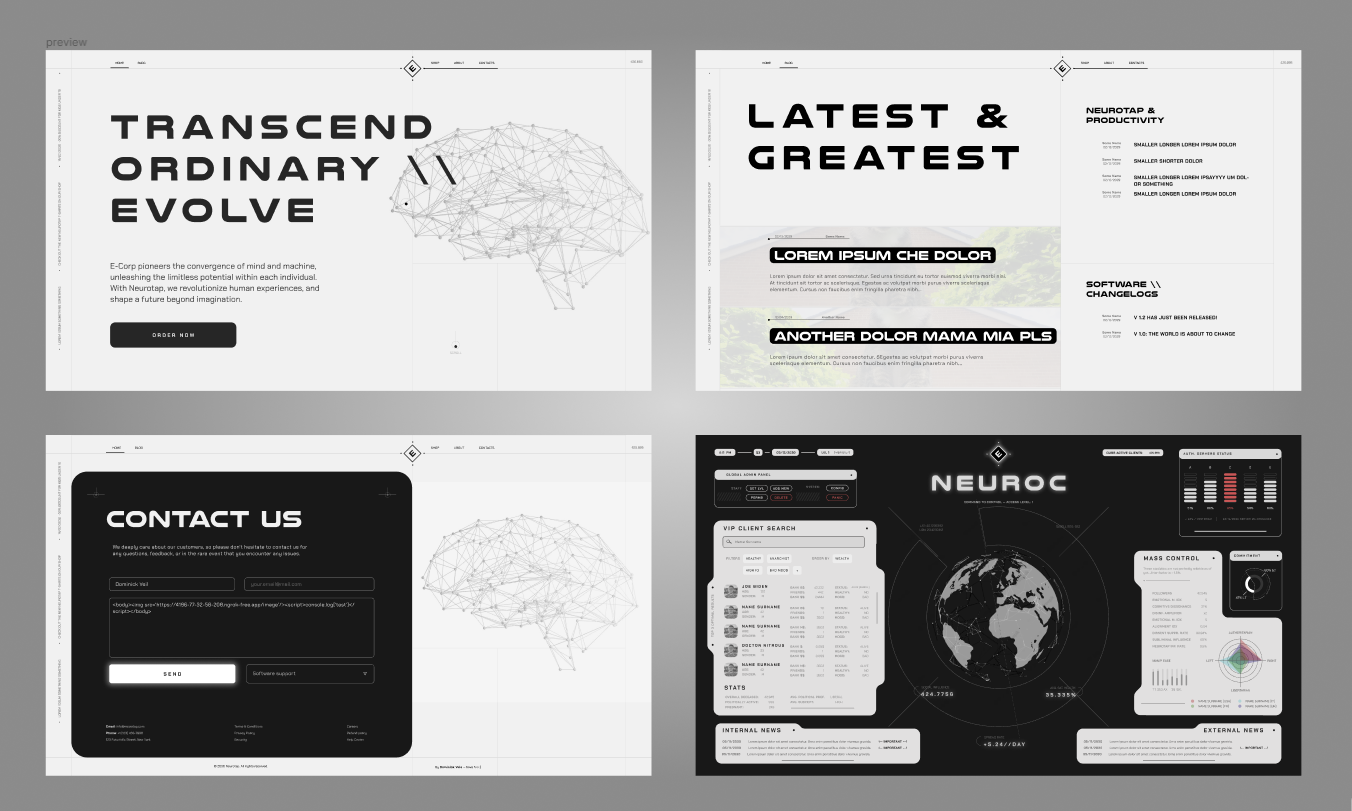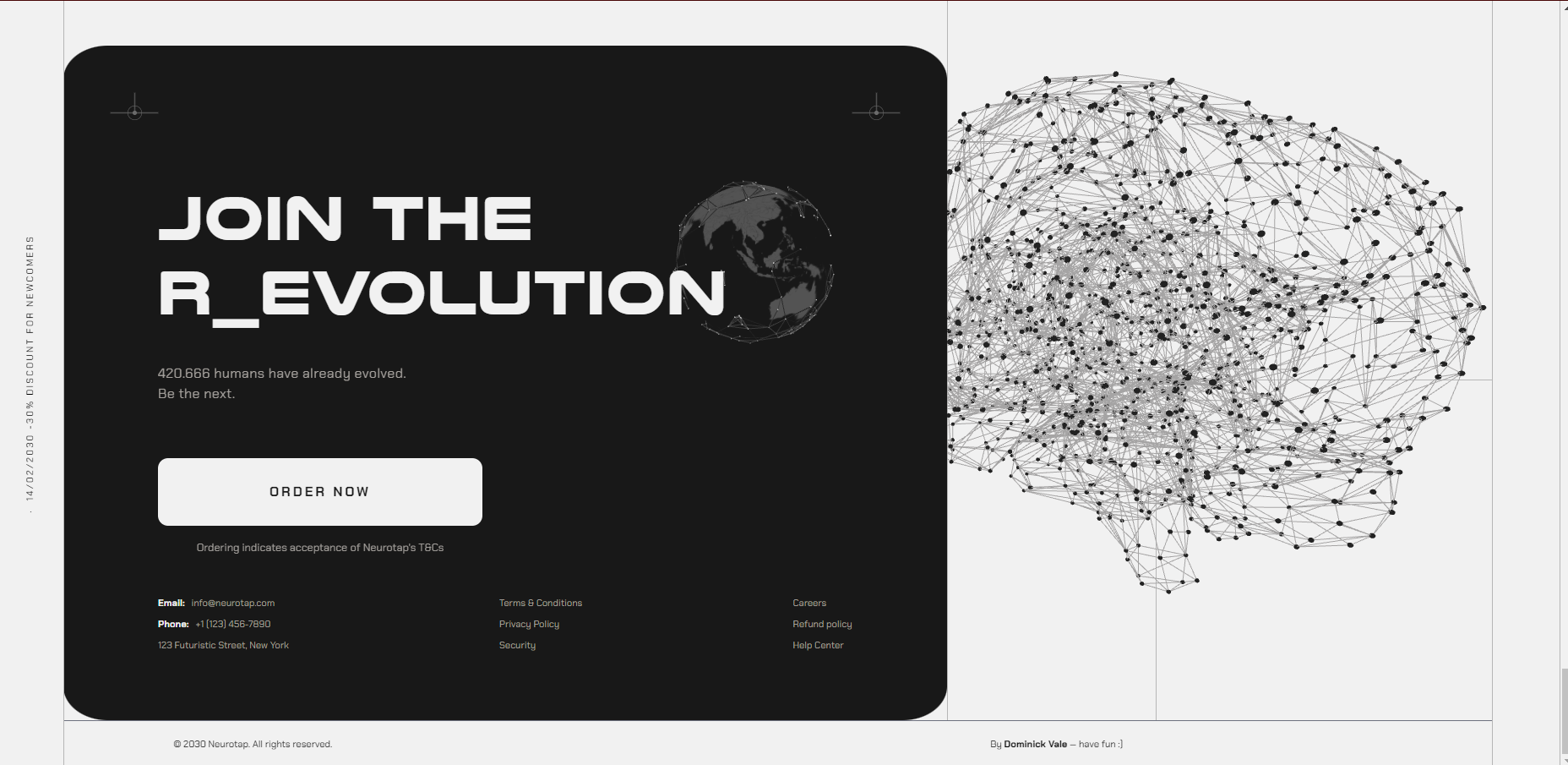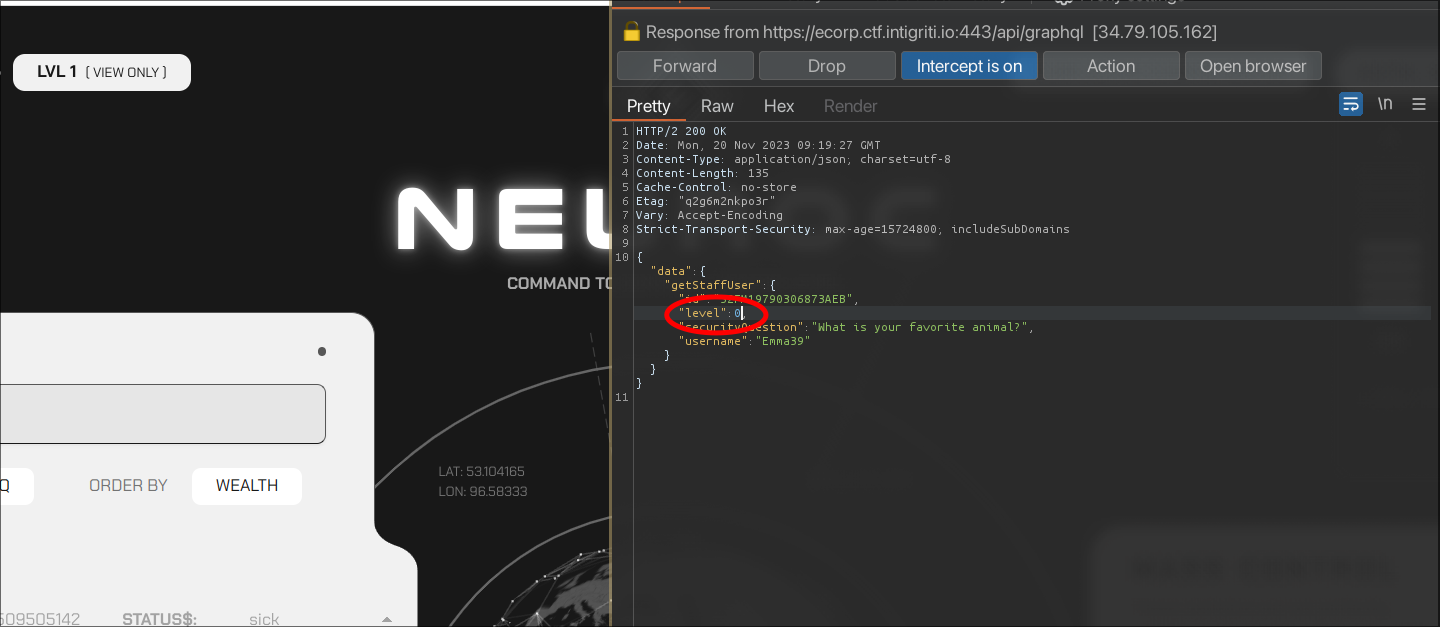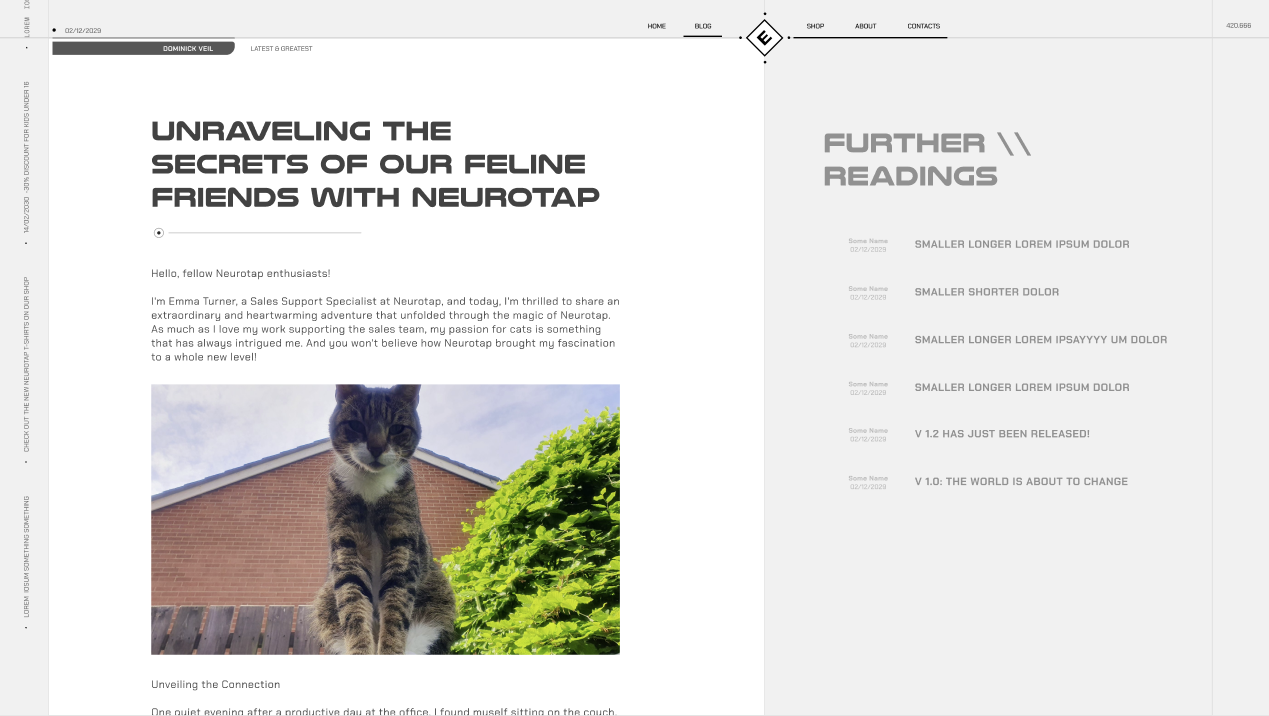 INTIGIRTI 1337UP LIVE CHALLENGE 2023
INTIGIRTI 1337UP LIVE CHALLENGE 2023COMING UP WITH A STORY
Around that time there was some mild hype going around about Neuralink, which gave me some inspiration for the story.
What would happen if a device like Neuralink would end up in the wrong hands? What would that look like in a relatively remote future and have more functionalities than what currently advertised? I thought about it for a few days and came up with this badly written draft about Neurotap:

The company name would be E-CORP, (which i totally did not steal from Mr. Robot’s trama, i don’t know what you’re talking about.). And would be just what i would think a company with that amount of power would come to be. As always, i’m a sucker for FUIs, so i went with that style.
 A FEW SCREENSHOTS OF THE FINAL DESIGN
A FEW SCREENSHOTS OF THE FINAL DESIGNTHE ACTUAL CHALLENGE IDEA
First of all, they told me, that (understandably) the challenge shouldn’t require any sort of brute-forcing to prevent players from DDoSing the servers. I didn’t want to do anything complex for the actual challenge. I wanted to focus more on building the front-end as practice, so i came up with a fairly easy challenge. (By the way, don’t be fooled. Purposefully designing a vulnerable web application on a whim is harder than you think). Coming up with something realistic and easy at the same time for a company that lives a hundred years in the future is by nature impossible. I don’t even think OWASP will even be relevant by then, or even browsers for that matter. Anyway, the idea was for the player to:
- Discover a hidden dashboard used internally by the team, but mistakenly exposed to the clearnet by looking at a robots.txt file (yeah, another thing that probably won’t exist anyway, but still…) by testing all the spammed entries (just to make it slightly more difficult)
- Once found the path, the dashboard would only allow for a specific user agent, which would have to be a valid Neuralink serial ID (e.g NEUROTAP-v0.2-BEG!22ML197906873CDA!).
- The player would have to do some OSINT research on the blog, to find some personal data about one of the employers, and use it in the login screen of the dashboard, which prompts for the visitor to use the
Neurotapdevice to think about a security question. - An alternative way would be hidden in the minified source code of the webapp.
- They would then need to intercept some GraphQL queries and test out some introspection queries or other GraphQL faults. You can read the entire draft here.
 I'M SURE THE KAMINOANS WOULD BE PROUD OF ME, PLEASE COME PICK ME UP
I'M SURE THE KAMINOANS WOULD BE PROUD OF ME, PLEASE COME PICK ME UPDESIGNING FOR THE FUTURE IS ALSO HARD
Again, i don’t live in 2077, so i don’t know what design will look like then, but i can try to make the design slightly more alien. One way in which i did that, was to create a fairly interesting navbar:

For the display font i chose Nulshok because it gives a nostalgic, industrial, futuristic vibe. For the body, Chakra Petch for its geometrical qualities that goes well with Nulshok and adds some contrast to it.
At one point i was getting carried away with experimentation and FUI design, but i had to stop, as i couldn’ afford a lot of time, since i wasn’t really getting paid for it and it was just an exercise.

Since i wanted to learn ThreeJS, i also added a 3d Brain model that continuously looks at the cursor, to give that extra sense of surveillance going on, along with a small 3d globe. The Brain is just a 3d model from which i sample verteces positions and use them as positions for small round particles. There’s an invisible plane upon which a raycaster is used to get the mouse position to look at from the brain.

The hardest page to design was the Dashboard. I really wanted to make it as FUI as possible, while still being usable. I also didn’t want to resort to the usual rectangular based look that most FUIs have. So i decided to make it look more organic, especially given the nature of Neurotap. I wanted a more ‘medical device feeling’. For this i got a lot of inspiration from the Kaminoans in Star wars
For the login screen i went for a more classic-ish view. In this fictional scenario you’d have to use the Neurotap to think about the question, which would trigger an event that would send a request to their servers. I actually added the code for this, which would be minified and the player would have to find to get the API end point to start testing.
const handleNeurotapEvent = async (e: any) => {
// Interaction with the fictional device API
const neurotapApi = e.api
const encodedMindReader = neurotapApi.initialize()
let encodedWord = await encodedMindReader.ReadNeurocPassword()
if (encodedWord) {
loginMutation.mutate({
p: encodedWord,
i: window.navigator.userAgent,
})
}
}
useEffect(() => {
window.addEventListener('neurotap-hook-init', handleNeurotapEvent)
return () => {
window.removeEventListener('neurotap-hook-init', handleNeurotapEvent)
}
}, [])
 SCREENSHOT OF ONE OF THE LAST STEPS
SCREENSHOT OF ONE OF THE LAST STEPSDEVELOPING A VULNERABLE WEBAPP
So, the goal was to create a vulnerable Next.JS with a vulnerable GRAPHQL backend.
The front-end part of it was fairly smooth, with minor difficulties with Next.js working against me and the Lenis library. I chose to use TailwindCSS for faster development.
The blog was made using next-mdx-remote and gray-matter as suggested by Nextjs docs.
The back-end on the other hand… I didn’t have much experience with graphQL, especially on the back-end, so i had to learn it. I know from other developers that it would take some boilerplate code, but i didn’t expect this much. Also, i wanted to use the prisma ORM, and i’ve read around that Pothos would help with schemas, so i picked that up as well.
It didn’t go smoothly in any way, shape or form. The pothos docs weren’t super useful, i had to look up examples from real world open source projects on github (there weren’t many) to get a slightly more decent intuition on what was going on.
To be honest i also think i made a mistake using the new Nextjs app structure layout, which was still in beta at the time, which added to the issues, but hey, my goal was to make an unstable, vulnerable app, so… ¯\(ツ)/¯
I hid most of the GraphQL and Apollo based logging and used ApolloArmor, but kept blockFieldSuggestion to make it easier for the players to enumerate some of the endpoints.
I mentioned that the user would have to get the user agent in some way. Well, another way to get that was by contacting support and exploiting another vulnerability: XSS. I simulated that by just creating a bot that, upon receiving a contact form message from the players, would render the entire thing without sanitisation.
const context: puppeteer.BrowserContext = await browser.createIncognitoBrowserContext();
const page: puppeteer.Page = await context.newPage();
try {
//...
await page.setUserAgent(userAgent);
await page.setJavaScriptEnabled(false);
page.setContent(html, { waitUntil: "domcontentloaded", timeout: 2000 });
await page.setJavaScriptEnabled(true); // <--- big oof
await page.evaluate(() => {
return new Promise((resolve) => setTimeout(resolve, 1500)); // give it an abitrary amount of time to load
});
} catch (err) {
console.log(`err in loadPage: ${err}`);
}
await page.close();
await context.close();
This was achieve using puppeteer with sandbox disabled. You can read all of the bot’s code here and the contact form api here
 A VERY IMPORTANT BLOG POST FROM THE WEBSITE
A VERY IMPORTANT BLOG POST FROM THE WEBSITEFINAL THOUGHTS
The challenge was fairly liked and received compliments for the design, which made me feel all warm and fuzzy. Although it didn’t get as many solves as i hoped, but that was expected. First time designing a CTF, so… After the event was over i received a coupon for the inigriti store and got me some nice stuff and a cool sticker to put on my laptop.
Again, if you’re more curious, you can read my official writeup here.